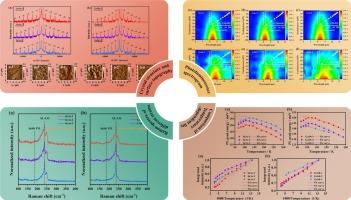Effect of strain on the long-wave infrared emission characteristics of InAs/InxGa1−xAsySb1−y type-Ⅱ superlattices on different substrates
IF 3.4
3区 物理与天体物理
Q2 INSTRUMENTS & INSTRUMENTATION
引用次数: 0
Abstract
Strain influences the optical properties of group III–V type-II superlattice (T2SL) materials. The performance of T2SL photodetectors containing InAs/GaSb is strongly affected by strain. Therefore, it is important to develop novel T2SL material systems and study the stress conditions between their epitaxial layers. Herein, the effect of strain on the long-wave infrared emission characteristics of InAs/InxGa1−xAsySb1−y T2SLs on InAs and GaSb substrates was investigated. Free, compressive, and tensile strains were adjusted by precisely controlling the alloy composition and thickness to realize zero, negative, and positive lattice mismatches, respectively, of T2SLs with InAs and GaSb substrates. The InAs/InxGa1−xAsySb1−y T2SLs were grown on InAs and GaSb substrates by molecular beam epitaxy and characterized by high-resolution X-ray diffraction, atomic force microscopy, Raman and photoluminescence (PL) measurements. The diffraction and microscopy results indicated that higher crystal quality and better surface morphology were obtained under free strain conditions with zero lattice mismatch on the same type of substrate. Higher crystal quality and better surface morphology were obtained on InAs than GaSb. Power-dependent PL spectra revealed that the luminescence characteristics of the T2SL are dominated by radiative recombination. Temperature-dependent PL spectra showed that the emission intensity of the T2SL on an InAs substrate is greater than that on GaSb. Compared with the T2SLs on GaSb substrates, those on InAs substrates retain strong PL emission intensity at higher temperature under the same strain conditions.

应变对不同衬底上InAs/InxGa1−xAsySb1−y型-Ⅱ超晶格长波红外发射特性的影响
应变影响III-V族ii型超晶格(T2SL)材料的光学性质。含InAs/GaSb的T2SL光电探测器的性能受应变的影响较大。因此,开发新型T2SL材料体系并研究其外延层之间的应力条件具有重要意义。本文研究了应变对InAs/InxGa1−xAsySb1−y T2SLs在InAs和GaSb衬底上长波红外发射特性的影响。通过精确控制合金成分和厚度来调节自由应变、压缩应变和拉伸应变,分别实现了T2SLs与InAs和GaSb衬底的零、负和正晶格失配。采用分子束外延的方法在InAs和GaSb衬底上生长了InAs/InxGa1−xAsySb1−y T2SLs,并通过高分辨率x射线衍射、原子力显微镜、拉曼和光致发光(PL)测量对其进行了表征。衍射和显微结果表明,在相同类型的衬底上,在零晶格失配的自由应变条件下,获得了更高的晶体质量和更好的表面形貌。InAs比GaSb具有更高的晶体质量和更好的表面形貌。功率相关的PL光谱表明,T2SL的发光特性主要受辐射复合的影响。随温度变化的PL光谱表明,T2SL在InAs衬底上的发射强度大于在GaSb上的发射强度。与GaSb衬底上的T2SLs相比,在相同的应变条件下,InAs衬底上的T2SLs在更高的温度下保持了较强的PL发射强度。
本文章由计算机程序翻译,如有差异,请以英文原文为准。
求助全文
约1分钟内获得全文
求助全文
来源期刊
CiteScore
5.70
自引率
12.10%
发文量
400
审稿时长
67 days
期刊介绍:
The Journal covers the entire field of infrared physics and technology: theory, experiment, application, devices and instrumentation. Infrared'' is defined as covering the near, mid and far infrared (terahertz) regions from 0.75um (750nm) to 1mm (300GHz.) Submissions in the 300GHz to 100GHz region may be accepted at the editors discretion if their content is relevant to shorter wavelengths. Submissions must be primarily concerned with and directly relevant to this spectral region.
Its core topics can be summarized as the generation, propagation and detection, of infrared radiation; the associated optics, materials and devices; and its use in all fields of science, industry, engineering and medicine.
Infrared techniques occur in many different fields, notably spectroscopy and interferometry; material characterization and processing; atmospheric physics, astronomy and space research. Scientific aspects include lasers, quantum optics, quantum electronics, image processing and semiconductor physics. Some important applications are medical diagnostics and treatment, industrial inspection and environmental monitoring.

 求助内容:
求助内容: 应助结果提醒方式:
应助结果提醒方式:


